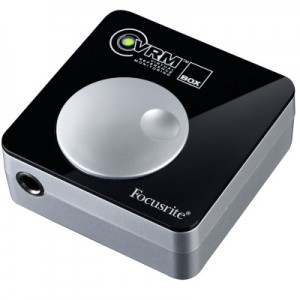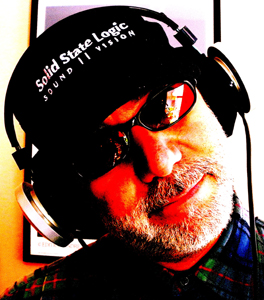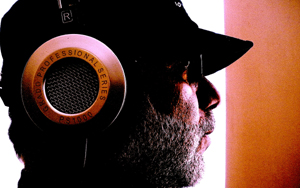“Mixology” with George Walker Petit: Real Mixers Mix in Headphones
I ride the 6 train sometimes, and it’s loud. The New York subway experience is degrading and filthy at worst, just plain noisy and jarring at best. Part of the NYC gig.
I also attend a neighborhood gym, and often could do without the ever-present bass thump and moronic lyric of most house dance music. Let’s consider the overly inquisitive child on the flight from JFK to LAX. Remember Bill Cosby’s “Jeffrey”? Google it, it’s on YouTube. Hilarious stuff. Or the screaming infant in seat 31C.
Car horns, fire trucks at 2am. New York is not a gentle and quiet place. Part of why we love it? Love it, hate it, love it, hate it, love it, hate it. Evelyn Mulwray to the white courtesy phone, please.
“Forget it Jake, it’s Chinatown.”
Be Quiet, I Can’t Hear You
The world intrudes on my focus and internal space far too often (“…dude, chill.”). I don’t think I have A.D.D. — HEY, LOOK! But I do miss the quiet at times. Not even quiet per se. I lose that focus, that “peace”. The world seems so full of external noise. Visually, I can deal, but I am a musician and an engineer: sound helps define my life. I can’t turn sound off, can’t ignore it. I hear rhythm in all things, harmony everywhere. But at some point, some times, I need to control it, at least try to attenuate/filter/regain my focus.
I remember sitting on a train with my wife, on the way to an airport at the close of our vacation. At Kandersteg station (we were in Switzerland), a significant herd of school kids joined us, hormones a-pumping. An uncontrollable group-howl of excitement. The look on Donna’s face was one of realization. Realization that our peaceful vacation was rushing toward a frenzied close. How this hurt me!
I reached into my briefcase and withdrew my trusty MP3 device and two pair of in ear monitors (IEM)’s with a splitter. We chose Brahms. We smiled. Blood pressures fell, smiles appearing. Into our own private world, our retreat, peace.
So I have IEM’s. Lots of IEM’s. IEM’s that fit well and…don’t fit so well. IEM’s that sound hyped and sound flat, loud and not loud, cheap and expensive. And this works! I can filter out the noise when I want to, when I need to. Nothing like riding the #4 express to Union Square and listening to Tom Waits. Surreal. Perfect. Tolerable.
The sanctuary of it. The sheer delight in not being forced to aurally participate in what is going on around you. Think of the peace, the seclusion, the focus, the efficiency.
You get it, right?
Let’s move on…
Armed (Eared) and Dangerous
I got that call again back in the Fall, that call to go to Brazil. I love that call. “Come on down, George, we need you to engineer a couple of sessions, and while you’re here you can teach our staff a bit, play some gigs, eat churrasco, drink cachaça and unwind, breathe in Brazil.” I love that call. It’s kinda quiet tonight. (hint, hint…)
I think the only bummer about the trip is the sound in their control room. The live room is a WSDG jewel, it’s gorgeous, huge. They now have the right mics as well, the console from my old studio, a bunch of great outboard, and a kind-hearted cook (‘Neide’) that makes a “corn cake” to MURDER for, and the churrasco nearby at Jardineira is about the best on the planet. Beats Fogo de Chao hands down.
But the sound of control room A for mixing, and the monitors…not so great. I track in A and then move the entire session, vibe, bevvies and body count to their B room to mix, hoping that what I tracked translates well. What a pain, and no, I am certainly not shipping my Proacs down there! For some reason I don’t fully grok, they don’t want to fix the room, or buy new monitors! Been to Brazil for work? Then you know…
So I bring my “SWEG’s”. Every time. They save the session for me. Every time. My “Secret Weapon Ear Goggles”. (music: accent here)
The Big Confession
Ok, ok…I blab, I meander. Let’s get to the point.
Look, I mix in headphones, ok? (enter: cries of derision from the chorus…)
Ok, ok…not all the time, but often, effectively and with a smile.
Ohh, here it comes! I anticipate sharp intakes of breath, chiding comments about lack of room interaction, the nature of stereophony, proximity of sound to (in) the head, poor frequency response, crosstalk, fatigue and discomfort, exaggerated panorama. Cries of “INFIDEL!” (“…dude, chill.”).
Yes, it’s true. I’ve reached the point where I feel that my headphone mixes are 100% valid and of high quality. Yes, I do take the cans off and check the mix on monitors periodically, as often as I would switch between different sets of monitors. Normal.
Fact is, there are many things one can learn from mixing in cans, things one can focus on microscopically, other benefits. Let’s talk about that.
Room interaction, stereophony. Not getting into the nitty on this stuff, ok? I am going to assume that you are already aware of (or can research) the physics of sound to the point where you understand the effects of a room and monitor placement on your work, how sound reaches your ears, etc… You should have a great and accurate room. Agreed? Good. We should spend a lot of time and money on acoustic design.
Acousticians — I know a few and they all deserve white lab coats. These guys and gals are Shamans…Shamen? Shawomen? They’re scary gurus. We all benefit from their knowledge and ability. But what if the room you are in was not designed by one of said gurus? What if the sound of the room basically…stinks? (oh no, surely not YOUR room, of course!)
How about the gear in the room? What if the studio monitors you have to use for your job are made by…oops! Almost got me! Let’s just say they are — less than adequate? Or maybe you’re just not used to them yet? What are you going to do? What are you going to do NOW, immediately?
Hey, what if you’re working in a home studio and you have the dreaded NEIGHBORS??
Ok, go on, lug your Genelecs around with you when you travel for work. Better yet, lug your Gene’s AND your Hothouse monitors with the matching Hothouse amp and Kimber cables…some do in fact. I don’t often have that luxury all the time.
Me? I “lug around” my extremely high end “SWEG’s” and their equally dangerous and sneaky “Cansamp” (someone please coin that). They travel in a small Pelican case. What exactly do I use? Tell ya later…
In yo’ FACE!
Over the years, I have enjoyed studying the work of many engineers (still do), getting inside their sound and trying to learn from their approach. I hope never to stop learning. We all have our mentors or those from whom we have shamelessly stolen tricks or techniques. Elliot, Al, Bob, James, Bruce. I could list 50 more.
I’ve found that by donning a great pair of ‘phones, I can really “see” what these greats are doing. I can hear mic placement, the room, the “digi” effects added, the subtleties of the mix, and the “whys and hows” of their magic. In headphones I can hear that with a closeness and precision that beats monitors. To get right up on the mic? To hear the “issues”? I go to the ‘phones.
Listen to one of Elliot’s mixes or Roger’s mixes: the panning, the detail, the precision. Instruments are tucked into just about every little nook and cranny of the panorama and soundstage. I can smell the room. What about Pink Floyd mixes? The AM radio transition in “Wish You Were Here”…stuff in the way far distance of a mix moving from ear to ear? Headphones, baby. Great engineers might or might not go to headphones for their work (some actually do), but when I want to get downright microscopic on mixes? I go to the ‘phones. Find the click, the pop, the mouth noise, the pencil hitting the music stand. Headphones. You want to get into this level of detail? Get the gear. Tell ya later.
ALL ABOARD !!
I recently read that “the majority of music is produced to be listened to in rooms with speakers”. Wow. As simple as that. Hell it was in one of those “big” audio magazines!…gotta be gospel, right? Not really…I looked up at the date of publishing and it was 2003. These days, the largest amount of produced music is being purchased by and marketed to a generation that chooses to experience their music on various “I-boxes” using “Eargizmos”. Come on…PLEASE argue with me. Then go look at the literally hundreds of IEM and portable music players out there. Every color of the rainbow, every size, models that are endorsed by Hollywood Stars!! Somehow I doubt the Stars spent hours at the bench testing “their” products.
This is the age of personal music experience, even you audiophiles reading this probably have IEM’s…they might have cost $9000, but you have them, just so that you can debate which model is of higher fidelity. I submit that we should be mixing at least to some degree with this in mind. There is not one mix job that I have done in the last ten years where I haven’t gone to earbuds or IEM’s to check the relative levels and low end.
Why? Come on, didn’t you do that with “Horror-Tones” for years? Or that little metal speaker on the Studer two-track? Come on, own up. Whether or not we are supporters of the quality of the MP3 format (or lack thereof), it’s a format here to stay, at least for a long while. Remember the big “Digital Debate”? You still stomping your feet? I maintain that if you are working with any genre of music that is going to be played on these little gizmos, you should work your mix on them as well. Get onboard or get left at the station. Adapt. Paradigms change. Deal.
Mine is better than yours!

Cranial evolutions continue with the likes of the Focusrite VRM (Virtual Reference Monitoring) system.
Sure it is. You like it more, it’s better. Most likely though, you’re just used to it. There are limitations in headphone design that will impact frequency response, comfort, accuracy and soundstage…funny, just like there are in monitors. Open back or closed back ‘phones? What kind of cabling? What is your source? Your headphone amp is at least as important as your headphones, surely. As a caring professional, I have to assume that you do your research, test and compare, settling on gear of the highest possible quality – dictated by your budget and your needs.
The technology is pretty advanced these days. At the top end of the food chain there is some pretty amazing-sounding equipment. All along that level and below, manufacturers are constantly developing tools to make your headphone environment more like your “room”. Some work, some don’t work as well. I urge you to get out there and check some of this stuff out. I bet it will change the way you look at mixing in headphones.
SPL, Focusrite, 112dB. Innovations that control speaker placement and angle, crosstalk, center level response. It’s impressive, when it works. And in some cases it certainly does work. I can say that with my chosen system, I can hear clear, strong and focused low end and smooth hi’s without the fatigue that so many associate with working in headphones. Times have indeed changed. And what about “familiarity”? How long did it take for you to get used to the sound of your best set of monitors so that you knew what to expect from a consumer level system after your work left your room? Do you not tailor your work to your equipment? Hell, I’ve heard fantastic mixes come out of rooms with only a set of mid-priced, near-field speakers, by great engineers that knew what they were doing and what to expect. That’s called experience.
The bottom line here is that you CAN mix in headphones accurately and comfortably now. Whether you need to or not, you can.
What’s more, the idiosyncrasies of headphones can certainly aid the process. Mixing in headphones works to differing degrees, depending on your level of experience, your equipment and its limitations, your knowledge of what you’re after and what you can expect. Basically it’s the same deal with monitors.
I’d rather mix a project with great headphones, a superior headphone amplifier that boasts such controls as Crosstalk, Speaker Angle and Center Level than mix the same project in a mediocre sounding room with marginal gear. I believe (and I support) that there is technology available to make this possible now. Consider getting more into it. It’s another source of reference.
What I am using…
Well, this is not a review. I am actually going to write a few of those soon and get FAR more detailed on this whole headphone thing, as well as writing some reviews about other studio gear. But for now, let’s say that I’ve compared what are considered to be the very top brands at their “flagship” level. Way up there in the stratosphere they’re all pretty impressive, let’s be clear.
But one has certain needs, and one works with certain types of music. I’ve settled on what I consider to be the very best combination for my needs and budget, and have found that these choices exhibit exceptional levels of sonic integrity, high quality construction and a sense of “reality” that is just staggering. What I use has brought me new enjoyment and excitement about my work and about listening to music. And this has been downright inspiring, and worth twice the price of admission. I am pretty blown away. I find it hard to take the ‘phones off these days.
My headphone monitoring system:
IEM’s: Grado GR10 and GR8
Headphones: Grado PS1000, SR325
I have been using Grado products for 20 years. The Grado product line has a quality and sound character that is present in all their models, true continuity through the line — a LOT more on this in an upcoming review of the Grado Sound.
Amplifier: SPL Phonitor
I am incredibly impressed by this unit, it is a total gamechanger. I can simply find no better or more flexible headphone amplifier, whether using their controls to effect Crosstalk Center Level and Speaker Angle, or just listening for enjoyment. The quality is unbeatable (IMNSHO!!).
Thanks for reading. The next installment will be about Mentoring, Teaching and…Theft.
Oh, and if you’re that guy on the #4 train with the HUGE cans with the big ‘b’ on the side? Could you please turn it down a bit?
Cheers !
gwp
George Walker Petit thinks a lot about mixing and many other musical things. An award-winning producer and mixer, he is based in New York City. Visit George at his Website, and keep up with him and the Drew Zingg Debut Album Project here.
Please note: When you buy products through links on this page, we may earn an affiliate commission.










Jamey Warren
April 4, 2011 at 2:21 pm (13 years ago)Thanks for posting this George. I’m surprised at how often people say you can’t mix with headphones. I fell in love with headphones many years ago for their ability to “see” into a recording like you’ve detailed above. Of course cross referencing on different systems is always important. I’m wondering if people are actually listening to music on headphones more than speakers these days?
Priscilla Esser
April 4, 2011 at 8:55 pm (13 years ago)I always pegged you for a “can” man.
Priscilla Esser
April 4, 2011 at 8:55 pm (13 years ago)I always pegged you for a “can” man.
Chris Mott
April 5, 2011 at 3:31 am (13 years ago)Grados kick butt! To see pictures and video of celebrities wearing their favorite headphones “head” on over to http://www.iloveheadphones.com It’s kind of fun!
tom
April 6, 2011 at 10:15 am (13 years ago)hi george, i enjoyed this discourse quite a bit. i’ve had a love/hate relationship with phones all my life. i finally ditched my electrostatic Stax w Class A a few years ago and didn’t look back…for a while. then this damn portable music thing lol. Etymotics, and a few others. Here i’ll date you: do you remember Binaural Recording? i got into that for a while (vinyl). many problems, many solutions. no one of which is perfect. remember ‘perfect sound forever’? bye
John D
April 6, 2011 at 2:47 pm (13 years ago)George: Great piece. Headphones it is then!
George
April 6, 2011 at 3:05 pm (13 years ago)Hey John ! Thanks for the comment…well, you KNOW i am digging them! cheers!
George
April 6, 2011 at 3:07 pm (13 years ago)Thanks, Tom – very kind. I am familiar of course with the STAX. Binaural as well. Perfect Sound Forever…amusing, marketing, misleading and…impossible !! Thanks for responding, I really appreciate the contact !
George
April 6, 2011 at 3:07 pm (13 years ago)…easy now, girl…
George
April 6, 2011 at 3:09 pm (13 years ago)Hey Jamey ! Well we know the answer to that one…they ARE ! In fact over 70% of the buying public are doing so primarily digitally and for use with IEM’s…we shouldn’t turn our backs on this as working professionals. Thanks for the contact -nice to meet you !!
George W
April 7, 2011 at 4:09 am (13 years ago)Your second paragraph reminded me of my experience at my gym on 17th street many years ago. They had a tape that was about a half-hour long, which they played through speakers way too small to handle the bottom end of the disco tracks with the “bass” knob stuck on 10. Every day for nearly a year, I would hear this coming out of the speakers:
Boomp
Boomp
Boomp
Boomp
Boomp
Boomp
Boomp
Boomp
Boomp
Boomp
Boomp
Boomp
Boomp
Boomp
Boomp
Boomp
IN MY MOUTH!
IN MY MOUTH!
IN MY MOUTH!
IN MY MOUTH!
IN MY MOUTH!
IN MY MOUTH!
IN MY MOUTH!
IN MY MOUTH!
IN MY MOUTH!
IN MY MOUTH!
IN MY MOUTH!
IN MY MOUTH!
IN MY MOUTH!
IN MY MOUTH!
IN MY MOUTH!
IN MY MOUTH!
Boomp
Boomp
Boomp
Boomp
Boomp
Boomp
Boomp
Boomp
Boomp
Boomp
Boomp
Boomp
Boomp
Boomp
Boomp
Boomp
Finally, during a discussion with my brother, who went to a different gym across town, I learned that all along, it actually went like this:
Boomp
Boomp
Boomp
Boomp
Boomp
Boomp
Boomp
Boomp
Boomp
Boomp
Boomp
Boomp
Boomp
Boomp
Boomp
Boomp
IN THE HOUSE!
IN THE HOUSE!
IN THE HOUSE!
IN THE HOUSE!
IN THE HOUSE!
IN THE HOUSE!
IN THE HOUSE!
IN THE HOUSE!
IN THE HOUSE!
IN THE HOUSE!
IN THE HOUSE!
IN THE HOUSE!
IN THE HOUSE!
IN THE HOUSE!
IN THE HOUSE!
IN THE HOUSE!
Boomp
Boomp
Boomp
Boomp
Boomp
Boomp
Boomp
Boomp
Boomp
Boomp
Boomp
Boomp
Boomp
Boomp
Boomp
Boomp
So the moral of the story is: if you’re going to destroy your speakers with dance tracks overdriven into pure square waves, you should expect that some of the subtleties of the lyric may be lost.
George
April 7, 2011 at 4:02 pm (13 years ago)Had a feeling that was you !!!
Matt Verzola
April 7, 2011 at 5:19 pm (13 years ago)“I also attend a neighborhood gym, and often could do without the ever-present bass thump and moronic lyric of most house dance music.”
I like and create that music, and actually consider the stuff that plays at the gym research into the genre. Not sure if I’d call the lyrics moronic, I mean I’m not exactly looking to trip out Pink Floyd-style while I’m pushing out my 10th rep. I think the point is that you’re not the DJ, and the music is forced upon you.
Daniel Meyer
April 7, 2011 at 6:51 pm (13 years ago)Beautiful article. Thank you so much for sharing.
George
April 8, 2011 at 1:59 pm (13 years ago)I agree in fact, Matt !
I don’t believe that ALL members of a particular gym are attending because of the music…some do enjoy/need the bumpbumpbump…but it is intrusive…plays loud and plays EVERYWHERE – even audible in the steam room, I think a place for peace and relaxation, not Gaga, although she would be welcome in most men’s gym steam rooms…sorry…another subject for an article? And while I am not likely to take my Grado’s IEM’s into the steam room…
Personally though, my experience with the genre’s content (at least at my gym) is that they ARE in fact pretty moronic lyrics…usually a looped line or two repeatedly dropped in over a looped beat. Opinions are what drives our world…
I am not looking for Floyd there either…you got the point though…part of my love for headphones or iem’s is the CHOICE factor…
No offense to your genre of choice, Matt…it’s just not my bag…as my bag might not be yours…
Thanks for reading, responding and commenting…the idea of these articles is to promote discussion…cheers! gwp
George
April 8, 2011 at 2:00 pm (13 years ago)Thank you, Daniel…appreciate that. More to come – I hope you will continue to visit and comment. gwp
Daniel Roberts
April 12, 2011 at 3:11 pm (13 years ago)Wow great article George! Keep up the good work! Dan Roberts
Gabe L
April 19, 2011 at 12:41 am (13 years ago)Wow, just now got to this article and I gotta say, FINALLY! With myself being a college student, it is obvious to assume that my budget isn’t the best, and living in a compact apartment…not the best place to be mixing late into the night. So I use AKG k701 combined with Focusrite’s Saffire Pro 24 DSP that had their VRM tech built in. I have not been able to invest into a standalone hp amp, but I am hoping you post more articles covering these types of things so that I can know what to look for from a person who has the experience and not some random dude writing on a gearslutz forum.
Chris
June 3, 2011 at 8:28 am (13 years ago)Great article, George. I don’t mix much these days anymore, so I went for the Auditor. Grados are phantastic phones (I have RS1s). I don’t follow, really, why people (on head-fi) who are strictly playing back music, spend twice as much on the Phonitor and mess with the recording. Or do they just like to twiddle knobs and stare at the VU meters? And why on earth are the HD-800s so popular? Gads…